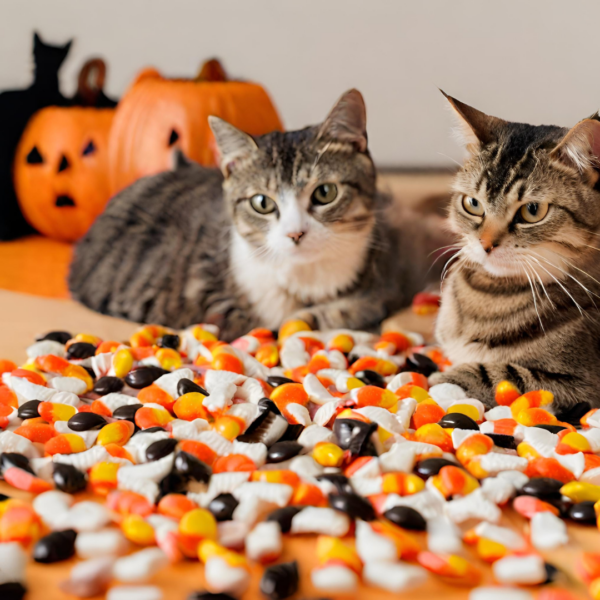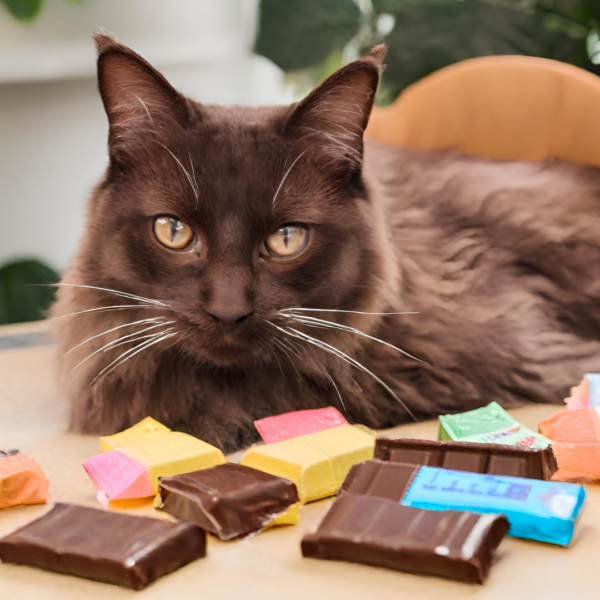
No! Chocolate is Toxic to Cats
Can cats eat chocolate? The simple answer is no; chocolate is toxic to cats and can seriously harm or even kill them. Although most of the poisoning cases reported are related to dogs, it is crucial to understand that chocolate is just as hazardous to the health of cats.
Chocolate is harmful to cats
Chocolate contains caffeine and theobromine, two dangerous stimulants that pose a threat to a cat’s health. Cats cannot break down and eliminate these substances like humans can, and as a result, they can suffer severe consequences if ingested. Therefore, it is vital to keep chocolate out of reach of your feline friend and be aware of the signs of chocolate poisoning.
Key Takeaways
- Cats should not eat chocolate as it is toxic to them.
- Chocolate poisoning in cats is caused by the presence of caffeine and theobromine.
- To prevent chocolate poisoning, keep chocolate away from your cat and be familiar with its symptoms.
Why Chocolate is Toxic to Cats
Chocolate is toxic to cats primarily due to the presence of theobromine and caffeine, two compounds that fall under the category of methylxanthines. These substances can have detrimental effects on a cat’s central nervous and cardiac systems.
Theobromine and Caffeine
Theobromine is a naturally occurring compound found in chocolate. It is a stimulant that affects the central nervous system and can cause a range of symptoms in cats. Cats are unable to break down and eliminate theobromine as efficiently as humans do, leading to a toxic buildup in their system when they consume chocolate.
Caffeine also acts as a stimulant within a cat’s body and is present in varying amounts in different types of chocolate. Like theobromine, cats are not able to metabolize caffeine effectively, causing toxicity when ingested.
In addition to being toxic, the problem is further compounded because cats are unable to perceive sweetness, which means they might ingest chocolate without being attracted by its sweet taste.
A few reasons why theobromine and caffeine are harmful to cats are presented below:
- Overstimulation of the central nervous system: Theobromine and caffeine both act as stimulants in cats, leading to hyperactivity, agitation, nervousness, and even seizures in severe cases.
- Cardiovascular issues: These compounds can increase a cat’s heart rate and blood pressure, resulting in arrhythmias, rapid breathing, and occasionally heart failure.
- Gastrointestinal problems: Ingesting chocolate can cause vomiting, diarrhea, and abdominal pain in cats, which can contribute to dehydration and electrolyte imbalances.
Levels of Toxicity Based on Type of Chocolate

Dark Chocolate
Dark chocolate contains the highest levels of theobromine, the toxic compound found in chocolate which is harmful to cats. Even small amounts of dark chocolate can be dangerous for a cat, causing symptoms such as vomiting, restlessness, and, in severe cases, seizures. It is crucial to keep this type of chocolate away from cats and ensure they do not have access to it.
White Chocolate
White chocolate contains minimal amounts of theobromine compared to other types of chocolates. However, it is still not safe for cats to consume. While the risk of toxicity may be lower, it is better to err on the side of caution and avoid giving white chocolate to your cat.
Milk Chocolate
Milk chocolate has lower levels of theobromine than dark chocolate but is still toxic to cats. The risk of toxicity depends on the amount of milk chocolate consumed. It is important to monitor your cat and seek veterinary assistance if they happen to ingest milk chocolate.
Baking Chocolate
Baking chocolate is another dangerous type of chocolate for cats as it contains high levels of theobromine. It is often used in making desserts and can be extremely potent. Like dark chocolate, even small amounts of baking chocolate can result in toxicity symptoms in cats.
When understanding the toxic dose of theobromine in cats, it’s essential to consider the type and amount of chocolate consumed. As noted, dark chocolate and baking chocolate present the highest risk due to their high theobromine content. Always take precautions with all types of chocolate and prevent cats from accessing them.
my cat ate chocolate. What Do I do?

Symptoms of Chocolate Poisoning in Cats
Early Stage Symptoms
In the early stages of chocolate poisoning, cats may exhibit symptoms such as:
- Vomiting: Occurs as their body tries to expel the chocolate and its toxic components.
- Diarrhea: Associated with ingestion of theobromine, a substance found in chocolate that is toxic to cats.
- Restlessness: Cats may become agitated or hyperactive due to the presence of caffeine in chocolate.
- Increased urination: The consumption of chocolate can cause increased thirst and urination in cats.
- Rapid breathing: As a result of chocolate poisoning, a cat’s respiratory rate may increase.
It is important to note that these early stage symptoms usually appear within 6-12 hours after chocolate ingestion and can last up to 3 days in severe cases.
Advanced Stage Symptoms
As chocolate poisoning progresses, the following advanced stage symptoms may develop in cats:
- Tremors: Chocolate poisoning can lead to muscle tremors and twitching, indicative of the worsening toxic effects.
- Seizures: A severe symptom of chocolate toxicity, seizures in cats can be potentially life-threatening if left untreated.
- Muscle rigidity: Ingestion of chocolate, particularly dark or baking chocolate, can cause muscle rigidity as the toxic components affect the cat’s nervous system.
- Bloating: A cat’s abdomen may become bloated and painful as a result of chocolate poisoning, potentially leading to pancreatitis.
- Abnormal heart rhythms: The presence of theobromine and caffeine in chocolate can cause increased heart rate and abnormal heart rhythms in cats, further endangering their health.
It is essential to closely monitor your cat if you suspect they have ingested chocolate. If your cat exhibits any of these symptoms, seek veterinary care immediately as chocolate poisoning can be fatal if not treated promptly.
First Aid and Treatment for Chocolate Poisoning in Cats

Emergency Steps
If you suspect your cat has ingested chocolate, the first thing to do is to remain calm and contact your veterinarian or an animal emergency clinic as soon as possible. They may advise you to induce vomiting, but do not do this without first consulting a veterinarian. This is because inducing vomiting can be dangerous for cats, depending on the amount and type of chocolate consumed.
Keep an eye on your cat and look for any signs of chocolate poisoning, such as vomiting, diarrhea, increased heart rate, and lethargy. Collect any remaining chocolate or vomit as a sample to bring with you to the veterinarian or clinic—this can help with the diagnosis and treatment.
Veterinary Treatment
Once you arrive at the veterinarian or emergency clinic, a professional will assess the severity of the poisoning and determine the appropriate treatment. It may include one or more of the following:
- Fluid therapy: Fluids are administered intravenously to help maintain hydration, support organ function, and eliminate toxins from the cat’s body more efficiently.
- Activated charcoal: Administering activated charcoal can help to absorb the toxins present in the cat’s gastrointestinal tract, preventing further absorption into the bloodstream.
- Medication: Depending on the symptoms your cat exhibits, the veterinarian may prescribe medications to counteract the effects of the chocolate, such as anti-nausea drugs, anticonvulsants, or medications to manage increased heart rate and blood pressure.
- Monitoring: It is crucial to closely monitor your cat during the treatment process. This may involve blood tests, evaluating vital signs, and observing for any changes in behavior or symptoms.
Taking prompt action and seeking veterinary care for your cat when chocolate poisoning is suspected is essential for the best possible outcome.
Preventive Measures and Safe Alternatives to Chocolate
It is crucial for pet parents to understand the risks associated with chocolate consumption in cats. Chocolate contains theobromine, a stimulant that is toxic to felines. Apart from stomach upset, ingestion of chocolate can lead to severe toxicity and even premature death in cats. Therefore, taking preventive measures and providing safe alternatives for treats is essential for ensuring your cat’s health and well-being.
To prevent cats from accidentally consuming chocolate, pet owners should store all chocolate products in a secure location that is out of reach for their feline companions. Additionally, it is important to educate family members and guests about the dangers of chocolate to cats to ensure they do not unintentionally feed chocolate to them.
safe alternative to chocolate
Safe alternatives to chocolate are available in the form of cat treats specifically designed for feline consumption. These treats come in various flavors and textures, catering to your cat’s preferences. Some popular options include:
- Dental treats: These are designed to help control plaque and tartar buildup, promoting good oral hygiene in cats.
- Soft, chewy treats: These treats are often easier to eat for older cats or those with dental issues. They also provide a different texture for cats who prefer softer foods.
- Fish-flavored treats: With flavors like salmon, tuna, and shrimp, these treats provide protein as well as Omega-3 fatty acids, which can benefit your cat’s coat and overall health.
- Freeze-dried treats: Made from meat or fish, these lightweight treats are a good option for those who want to provide their cats with a more natural snack.
Pet parents should always check the ingredients and opt for high-quality, well-formulated treats to ensure their cat’s health and happiness. By taking these preventive measures and providing safe alternatives for treats, cat owners can highly reduce the risks associated with chocolate consumption and foster a healthy, happy living environment.
Other Dangerous Foods for Cats

Xylitol
Xylitol, a sugar substitute often found in sugar-free products, is extremely dangerous for cats. Ingestion of even small amounts can lead to insulin release, rapid decrease in blood sugar, and potentially death. Always keep products containing xylitol, such as sugar-free gum or candy, out of reach of your cat.
Grapes and Raisins
Grapes and raisins are harmful to cats as they can result in kidney failure, even when ingested in small quantities. The exact cause for this toxicity is still unknown. Make sure your cat does not have access to these fruits when sharing human food or table scraps.
Onions and Garlic
Onions and garlic are toxic to cats, causing damage to their red blood cells and possibly leading to anemia. This includes all forms of onions and garlic, such as raw, cooked, and powdered varieties. Cats should never be fed dishes containing these ingredients.
Raw Eggs
Feeding cats raw eggs is not recommended due to the risk of salmonella and E. coli infections. Additionally, a protein called avidin found in raw egg whites can interfere with the absorption of the B vitamin biotin, potentially causing skin and coat issues.
Bread Dough and Yeast
Ingesting unbaked bread dough containing yeast can be harmful to cats. Yeast ferments in their stomach, producing ethanol and carbon dioxide. This can result in bloating, abdominal pain, and even alcohol toxicosis. Keep raw dough out of reach and be cautious when baking at home.
Alcohol and Coffee
Both Alcohol and coffee are dangerous to cats, even in small quantities. Alcohol can cause central nervous system issues, and coffee contains caffeine, which can lead to rapid heart rate, tremors, and even seizures. It’s essential to keep alcoholic beverages and caffeinated drinks away from your cat.
Feeding cats table scraps and human foods can potentially lead to diabetes, obesity, and other health issues. It’s crucial to know which foods are toxic to cats and ensure their diet consists mostly of high-quality, species-appropriate food.
Conclusion

Cats should not eat chocolate, as it is toxic to them and can lead to poisoning. Chocolate toxicity in cats occurs due to the presence of theobromine, a stimulant found in chocolate and other products derived from cocoa beans. Even though cats cannot taste sweet things and are less likely to eat chocolate compared to dogs, the risks and dangers associated with chocolate consumption still apply.
If a cat consumes chocolate, it may experience serious health issues that can be fatal if left untreated. It is essential for cat owners to be aware of the risks associated with chocolate and to keep chocolate products out of reach from their feline friends.
In the event that a cat has eaten chocolate, pet owners should contact their veterinarian or the Pet Poison Helpline immediately. Early intervention is critical in minimizing the adverse effects of chocolate toxicity in cats and ensuring their well-being.
While it may be tempting to share a treat with our feline companions, it is crucial to remember that chocolate is not safe for cats. Providing them with cat-specific treats and adhering to a well-balanced diet will ensure their health and happiness without exposing them to the dangers of chocolate toxicity.
Frequently Asked Questions
What are the symptoms of chocolate poisoning in cats?
Chocolate poisoning in cats can cause a variety of symptoms, including low blood pressure, rapid breathing, muscle rigidity, and increased thirst. Cats may also experience vomiting, diarrhea, and pain within 2 to 4 hours of ingestion. Clinical signs of chocolate toxicity usually occur within 6 to 12 hours and can last up to 3 days in severe cases.
How much chocolate is toxic for a cat?
Any amount of chocolate a cat eats is potentially toxic for cats. The risk depends on the type of chocolate and the amount ingested. Baking and dark chocolates, which have higher concentrations of theobromine and caffeine, pose a greater danger to cats. Even small quantities can be harmful.
Are there any home remedies for chocolate ingestion in cats?
If a cat eats chocolate, it is crucial to contact a veterinarian or the Pet Poison Helpline at 855-764-7661 immediately. Do not attempt any home remedies, as chocolate ingestion is a medical emergency that requires professional intervention for the best outcome.
Is chocolate more harmful to cats or dogs?
Chocolate is toxic to both cats and dogs, but it appears to be more common in dogs due to their greater likelihood of consuming chocolate. Cats generally don’t have a taste for sweets, so instances of chocolate ingestion are less frequent. However, when cats do consume chocolate, the toxicity is just as severe.
What happens if a cat licks chocolate?
If a cat only licks a small amount of chocolate, the risk of toxicity may be lower than if the cat eats a larger piece. However, it’s important to monitor the cat for any signs of chocolate poisoning and consult a veterinarian immediately if symptoms appear. It’s always better to err on the side of caution and seek professional advice.
Can cats have white chocolate or chocolate-flavored milk?
While white chocolate and chocolate-flavored milk contain lower levels of theobromine and caffeine compared to other chocolate types, they still pose a risk to cats. It is best to avoid giving any chocolate products to cats to prevent accidental poisoning.